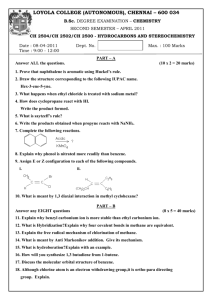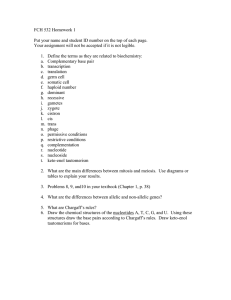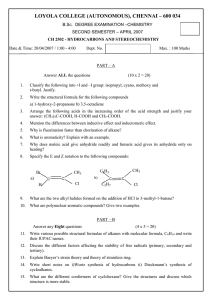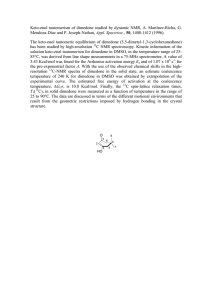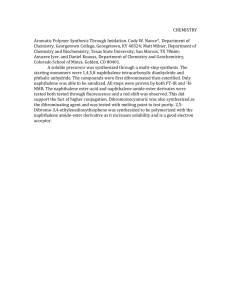CH 2504 2502
advertisement
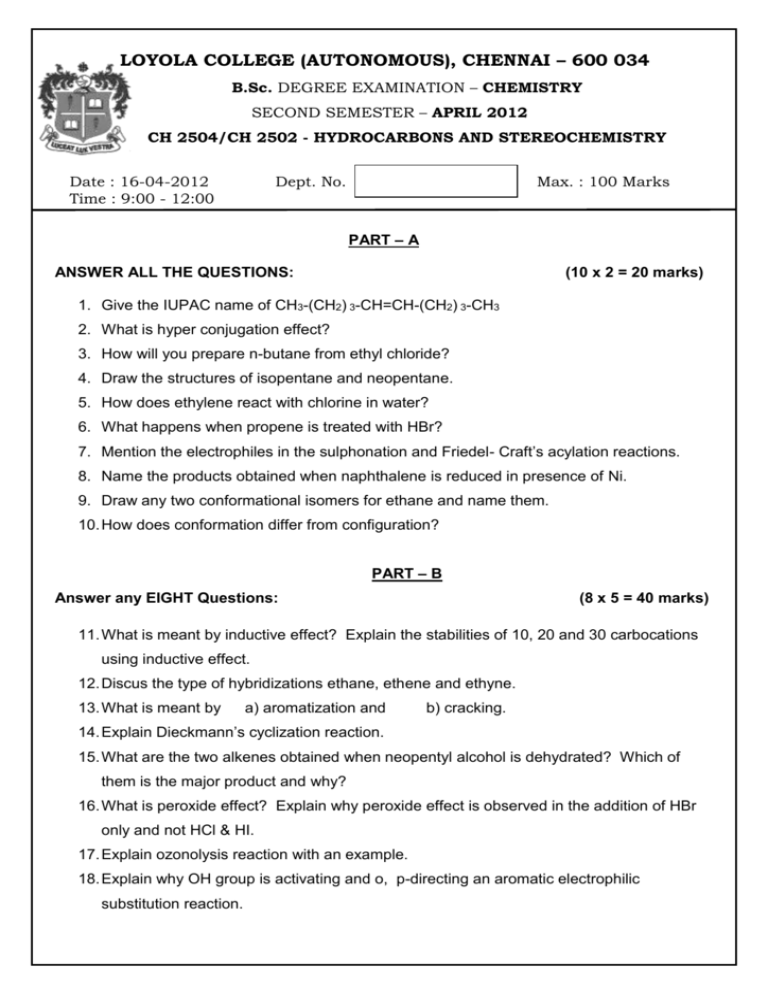
LOYOLA COLLEGE (AUTONOMOUS), CHENNAI – 600 034 B.Sc. DEGREE EXAMINATION – CHEMISTRY SECOND SEMESTER – APRIL 2012 CH 2504/CH 2502 - HYDROCARBONS AND STEREOCHEMISTRY Date : 16-04-2012 Time : 9:00 - 12:00 Dept. No. Max. : 100 Marks PART – A ANSWER ALL THE QUESTIONS: (10 x 2 = 20 marks) 1. Give the IUPAC name of CH3-(CH2) 3-CH=CH-(CH2) 3-CH3 2. What is hyper conjugation effect? 3. How will you prepare n-butane from ethyl chloride? 4. Draw the structures of isopentane and neopentane. 5. How does ethylene react with chlorine in water? 6. What happens when propene is treated with HBr? 7. Mention the electrophiles in the sulphonation and Friedel- Craft’s acylation reactions. 8. Name the products obtained when naphthalene is reduced in presence of Ni. 9. Draw any two conformational isomers for ethane and name them. 10. How does conformation differ from configuration? PART – B Answer any EIGHT Questions: (8 x 5 = 40 marks) 11. What is meant by inductive effect? Explain the stabilities of 10, 20 and 30 carbocations using inductive effect. 12. Discus the type of hybridizations ethane, ethene and ethyne. 13. What is meant by a) aromatization and b) cracking. 14. Explain Dieckmann’s cyclization reaction. 15. What are the two alkenes obtained when neopentyl alcohol is dehydrated? Which of them is the major product and why? 16. What is peroxide effect? Explain why peroxide effect is observed in the addition of HBr only and not HCl & HI. 17. Explain ozonolysis reaction with an example. 18. Explain why OH group is activating and o, p-directing an aromatic electrophilic substitution reaction. 19. Discuss the mechanism of nitration of benzene. 20. Discuss the conformational analysis of n-butane. 21. What is geometrical isomerism? Discuss any two methods of differentiating geometric isomers. 22. Discuss the relative stabilities of chair and boad conformations of cyclohexane. PART – C Answer any FOUR Questions: (4 x 10 = 40 marks) 23. a) Explain keto-enol tautomerism by taking acetoacetic ester as an example b) Write the mechanism of keto-enol tautomerism. (5+5) 24. a) Expalin the mechanism of halogenations of alkanes. b) Explain Baeyer’s strain theory. (5+5) 25. a) What is meant by allylic substitution? Give the mechanism of the reaction. b) Comapre the acid strengths of ethane. Ethylene and acetylene. (5+5) 26. a) Explain Diels-Alder reaction and mention its synthetic applications. b) Explain aromaticity of benzene using Huckel’s rule. (5+5) 27. a) Outline Haworth’s synthesis of naphthalene. b) Name the products obtained when naphthalene is oxidized with i) KMnO4 ii) V2O5 iii) CrO3 (5+5) 28. a) Explain why equatiorial conformation of methylcyclohexane is more stable than the corresponding axial conformation. b) What is 1,3-diaxial interaction? (7+3) $$$$$$$
